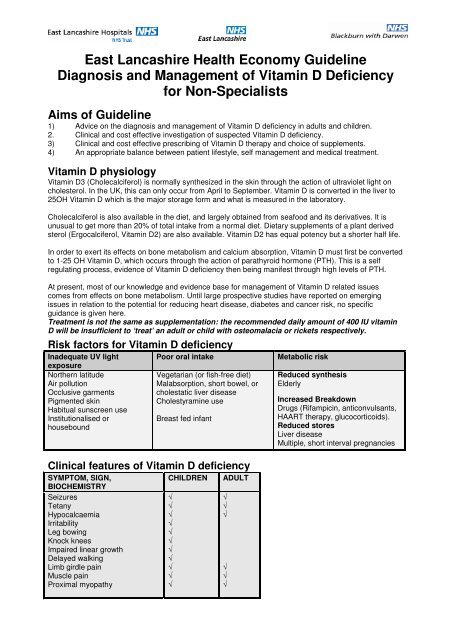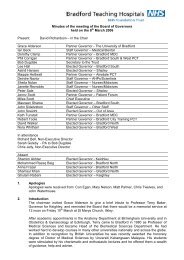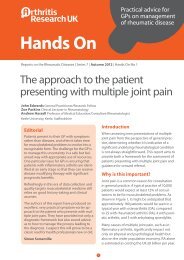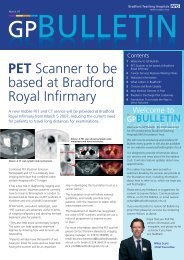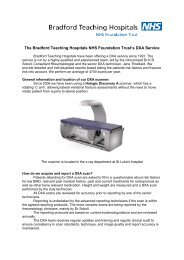Diagnosis and Management of Vitamin D Deficiency for Non ...
Diagnosis and Management of Vitamin D Deficiency for Non ...
Diagnosis and Management of Vitamin D Deficiency for Non ...
You also want an ePaper? Increase the reach of your titles
YUMPU automatically turns print PDFs into web optimized ePapers that Google loves.
East Lancashire Health Economy Guideline<br />
<strong>Diagnosis</strong> <strong>and</strong> <strong>Management</strong> <strong>of</strong> <strong>Vitamin</strong> D <strong>Deficiency</strong><br />
<strong>for</strong> <strong>Non</strong>-Specialists<br />
Aims <strong>of</strong> Guideline<br />
1) Advice on the diagnosis <strong>and</strong> management <strong>of</strong> <strong>Vitamin</strong> D deficiency in adults <strong>and</strong> children.<br />
2. Clinical <strong>and</strong> cost effective investigation <strong>of</strong> suspected <strong>Vitamin</strong> D deficiency.<br />
3) Clinical <strong>and</strong> cost effective prescribing <strong>of</strong> <strong>Vitamin</strong> D therapy <strong>and</strong> choice <strong>of</strong> supplements.<br />
4) An appropriate balance between patient lifestyle, self management <strong>and</strong> medical treatment.<br />
<strong>Vitamin</strong> D physiology<br />
<strong>Vitamin</strong> D3 (Cholecalciferol) is normally synthesized in the skin through the action <strong>of</strong> ultraviolet light on<br />
cholesterol. In the UK, this can only occur from April to September. <strong>Vitamin</strong> D is converted in the liver to<br />
25OH <strong>Vitamin</strong> D which is the major storage <strong>for</strong>m <strong>and</strong> what is measured in the laboratory.<br />
Cholecalciferol is also available in the diet, <strong>and</strong> largely obtained from seafood <strong>and</strong> its derivatives. It is<br />
unusual to get more than 20% <strong>of</strong> total intake from a normal diet. Dietary supplements <strong>of</strong> a plant derived<br />
sterol (Ergocalciferol, <strong>Vitamin</strong> D2) are also available. <strong>Vitamin</strong> D2 has equal potency but a shorter half life.<br />
In order to exert its effects on bone metabolism <strong>and</strong> calcium absorption, <strong>Vitamin</strong> D must first be converted<br />
to 1-25 OH <strong>Vitamin</strong> D, which occurs through the action <strong>of</strong> parathyroid hormone (PTH). This is a self<br />
regulating process, evidence <strong>of</strong> <strong>Vitamin</strong> D deficiency then being manifest through high levels <strong>of</strong> PTH.<br />
At present, most <strong>of</strong> our knowledge <strong>and</strong> evidence base <strong>for</strong> management <strong>of</strong> <strong>Vitamin</strong> D related issues<br />
comes from effects on bone metabolism. Until large prospective studies have reported on emerging<br />
issues in relation to the potential <strong>for</strong> reducing heart disease, diabetes <strong>and</strong> cancer risk, no specific<br />
guidance is given here.<br />
Treatment is not the same as supplementation: the recommended daily amount <strong>of</strong> 400 IU vitamin<br />
D will be insufficient to ‘treat’ an adult or child with osteomalacia or rickets respectively.<br />
Risk factors <strong>for</strong> <strong>Vitamin</strong> D deficiency<br />
Inadequate UV light<br />
exposure<br />
Northern latitude<br />
Air pollution<br />
Occlusive garments<br />
Pigmented skin<br />
Habitual sunscreen use<br />
Institutionalised or<br />
housebound<br />
Poor oral intake<br />
Vegetarian (or fish-free diet)<br />
Malabsorption, short bowel, or<br />
cholestatic liver disease<br />
Cholestyramine use<br />
Breast fed infant<br />
Clinical features <strong>of</strong> <strong>Vitamin</strong> D deficiency<br />
SYMPTOM, SIGN,<br />
BIOCHEMISTRY<br />
Seizures<br />
Tetany<br />
Hypocalcaemia<br />
Irritability<br />
Leg bowing<br />
Knock knees<br />
Impaired linear growth<br />
Delayed walking<br />
Limb girdle pain<br />
Muscle pain<br />
Proximal myopathy<br />
CHILDREN<br />
√<br />
√<br />
√<br />
√<br />
√<br />
√<br />
√<br />
√<br />
√<br />
√<br />
√<br />
ADULT<br />
√<br />
√<br />
√<br />
√<br />
√<br />
√<br />
Metabolic risk<br />
Reduced synthesis<br />
Elderly<br />
Increased Breakdown<br />
Drugs (Rifampicin, anticonvulsants,<br />
HAART therapy, glucocorticoids).<br />
Reduced stores<br />
Liver disease<br />
Multiple, short interval pregnancies
Assessing the ‘patient’<br />
Population screening by measuring <strong>Vitamin</strong> D levels is unnecessary even in high risk populations.<br />
Patient characteristics<br />
Healthy, no risk factors, symptom free<br />
Risk factors only (see above)<br />
Risk factors AND symptoms/signs<br />
Advice <strong>and</strong> management<br />
No investigations required<br />
Lifestyle advice<br />
Consider preventive therapies<br />
Lifestyle advice<br />
Consider long term preventative therapies<br />
Lifestyle advice<br />
Investigations<br />
Therapeutic intervention<br />
Long term preventative treatment<br />
Investigations<br />
Test<br />
Renal function<br />
Liver function (albumin)<br />
FBC<br />
Parathyroid hormone<br />
Calcium<br />
Phosphate<br />
Alkaline phosphatise<br />
----------------------------------------------------<br />
25OH <strong>Vitamin</strong> D levels<br />
----------------------------------------------------<br />
1-25OH <strong>Vitamin</strong> D levels<br />
24h urine calcium<br />
Reason<br />
Exclude renal disease<br />
Iron deficiency commonly co-exists<br />
----------------------------------------------------------------<br />
See below <strong>for</strong> guidance on whether to assay<br />
----------------------------------------------------------------<br />
ONLY if granulomatous disease suspected<br />
ONLY where <strong>Vitamin</strong> D excess suspected<br />
Measurement & Interpretation <strong>of</strong> serum 25-hydroxyvitamin D<br />
concentrations<br />
Is it necessary to always assay serum 25-hydroxyvitamin D concentrations?<br />
Children – Yes, all children with suspected vitamin D deficiency should have their levels assayed.<br />
Adults – Not necessarily. <strong>Vitamin</strong> D deficiency can be assumed <strong>for</strong> those adults presenting with<br />
classical symptoms/signs <strong>of</strong> vitamin D deficiency AND with known risk factors AND with abnormal<br />
biochemistry (e.g. raised Alk Phos). They can be started on empirical ‘maintenance’ treatment with<br />
vitamin D. However, not all patients with symptoms/signs <strong>of</strong> vitamin D deficiency will have abnormal<br />
biochemistry, <strong>and</strong> in these cases assaying <strong>of</strong> vitamin D levels is the definitive diagnostic method.<br />
Serum 25-hydroxyvitamin D concentrations, status <strong>and</strong> management<br />
40ng/mL<br />
Insufficiency: long term maintenance treatment required<br />
Healthy, give lifestyle advice<br />
Optimal<br />
Referral to a specialist is advised <strong>for</strong> the following groups <strong>of</strong> patients.<br />
All children under 1 year Atypical biochemistry Atypical clinical<br />
manifestations or<br />
biochemistry<br />
Focal bone pain<br />
<strong>Deficiency</strong> due to<br />
malabsorption<br />
Failure to respond to<br />
treatment after 3 months<br />
Liver disease Lymphoma Metastatic cancer<br />
Parathyroid disorders Renal disease Renal stones<br />
Sarcoidosis Short stature Skeletal de<strong>for</strong>mity<br />
Tuberculosis Unexplained deficiency Unexplained weight loss
Advice on prescribing <strong>of</strong> <strong>Vitamin</strong> D <strong>and</strong> calcium supplements<br />
<strong>for</strong> ADULTS<br />
Daily treatment with <strong>Vitamin</strong> D (either Cholecalciferol or Ergocalciferol) is associated with a rise in<br />
measured vitamin D levels, representing an increased amount <strong>of</strong> stored <strong>Vitamin</strong> D. In adults, each 100<br />
units <strong>of</strong> vitamin D taken daily will normally raise vitamin D levels by 1 ng/ml. Provided basic investigations<br />
are undertaken be<strong>for</strong>e treatment <strong>and</strong> renal disease, liver disease, primary hyperparathyroidism <strong>and</strong><br />
inflammatory conditions have been excluded, then <strong>Vitamin</strong> D toxicity is very rare. Toxicity is normally only<br />
seen when the blood level exceeds 90ng/ml (220nmol/l). Extremely large daily doses in excess <strong>of</strong> 250<br />
mcg or 10,000 units are generally required to achieve this (Hathcock et al 2007).<br />
Patient characteristics<br />
‘<strong>Deficiency</strong>’ in<br />
adults (
Advice on prescribing <strong>of</strong> <strong>Vitamin</strong> D <strong>and</strong> calcium supplements<br />
<strong>for</strong> CHILDREN.<br />
If a child has vitamin D insufficiency or deficiency it is probable the mother <strong>and</strong> other siblings are similarly<br />
affected. They will need testing <strong>and</strong> may need therapy as well.<br />
<strong>Deficiency</strong> treatment in children (
Supplementary In<strong>for</strong>mation<br />
Monitoring requirements<br />
Important. All patients receiving therapy <strong>for</strong> vitamin D deficiency should be monitored as follows:<br />
• 1 month: plasma-calcium concentration checked<br />
• 3 months: plasma-calcium, phosphate, alkaline phosphatase <strong>and</strong> parathyroid hormone* checked.<br />
*Measuring PTH is difficult in the community because the sample has to reach the lab within four hours.<br />
Ensure sample taken at correct time to allow transport to lab <strong>for</strong> analysis, <strong>and</strong> sample is clearly labelled.<br />
Important. All patients receiving calcium supplementation <strong>for</strong> hypocalcaemia, in addition to<br />
pharmacological doses <strong>of</strong> vitamin D need more frequent monitoring <strong>of</strong> plasma-calcium every 1-2 weeks in<br />
the first months <strong>of</strong> treatment to determine length <strong>of</strong> time calcium supplementation is needed <strong>and</strong> to avoid<br />
hypercalcaemia. Patients or carers should be in<strong>for</strong>med about the symptoms <strong>of</strong> hypercalcaemia e.g.<br />
weight loss, sickness, vomiting, headache, abdominal pain, apathy, polyuria.<br />
Available <strong>Vitamin</strong> D preparations<br />
The BNF lists two single ingredient products <strong>of</strong> high dose ergocalciferol (e.g. Ergocalciferol tablets 10,000<br />
& 50,000 international units). Due to ongoing supply problems neither <strong>of</strong> these preparations are currently<br />
available in the UK. As such, the recommendations below outline the range <strong>of</strong> alternative products which<br />
may be available, the doses recommended, <strong>and</strong> the cost. See below & above.<br />
Special considerations in relation to the preparation used.<br />
• Ability to take or absorb oral medication (e.g. malabsorption)<br />
• Gelatin excipients in capsules may be <strong>of</strong> Porcine origin (see ‘supplemental in<strong>for</strong>mation’ overleaf)<br />
• Tolerability in selected patients<br />
•<br />
Supplies <strong>of</strong> higher dose vitamin D preparations:<br />
There are two preparations that could be imported <strong>and</strong> are considered <strong>of</strong> suitable strength <strong>for</strong> intermittent<br />
dosing in primary vitamin D deficiency:<br />
Preferred product: Colecalciferol (Dekristol®) 20,000 units x 50 capsules (£16 approx) [Unlicensed<br />
import]. (Dekristol®, MIBE, Brehna, Germany). Likely to incur additional delivery charge.<br />
Alternative: Ergocalciferol capsules 1.25mg (50 000 units) x 50 (£273 approx) [Unlicensed import]. Likely to incur<br />
additional delivery charge.<br />
Colecalciferol capsules are the more readily available <strong>and</strong> the cheaper preparation. Both <strong>of</strong> these<br />
products are likely to contain gelatin. Community pharmacists can obtain these preparations from an<br />
import company (see BNF <strong>for</strong> details), with delivery taking about two days.<br />
Injection<br />
There is a licensed UK injection <strong>of</strong> ergocalciferol. This is gelatin free <strong>and</strong> is currently available. An<br />
intermittent regimen <strong>for</strong> primary vitamin D deficiency would be <strong>of</strong>f-label (see previously).<br />
Ergocalciferol, 7.5 mg (300 000 units)/mL in oil, Injection <strong>for</strong> intramuscular use only. 1-mL amp = £7.45,<br />
2-mL amp = £8.95.<br />
NOT RECOMMENDED: Named patient liquid ‘specials’ <strong>of</strong> vitamin D<br />
(unlicensed) <strong>for</strong> adults in primary care should NOT be routinely prescribed.<br />
Due to the exorbitant cost <strong>of</strong> some <strong>of</strong> these preparation in primary care (e.g. up to £500 <strong>for</strong> 30ml)<br />
these should NOT be routinely prescribed. A named patient supply <strong>of</strong> an unlicensed liquid<br />
preparation <strong>of</strong> vitamin D should only be used in exceptional circumstances where patients are<br />
unable to use colecalciferol capsules or the injection above (e.g. PEG feeding & needle phobic).<br />
An ergocalciferol or colecalciferol oral solution can be obtained by a community pharmacist from a<br />
specials manufacturer. The manufacturer will prepare any strength <strong>and</strong> volume required. These solutions<br />
are very expensive (the price being determined by the strength <strong>and</strong> volume ordered) <strong>and</strong> have a short<br />
shelf life <strong>of</strong> one to two months from the date <strong>of</strong> manufacture. These solutions would be gelatin free. Oral<br />
solutions could be given on a daily basis depending on the strength.<br />
Only where absolutely necessary: Cholecalciferol solution 1500 units/ml 20mL (e.g Uvesterol D®) or<br />
10,000 units/mL both unlicensed specials [usually 28 day expiry] are available from specials<br />
manufacturers. Details <strong>of</strong> such companies <strong>and</strong> others can be found in the BNF.
Alfacalcidol/Calcitriol (Specialist initiation only)<br />
Alfacalcidol <strong>and</strong> Calcitriol have no routine place in the management <strong>of</strong> primary vitamin D deficiency <strong>and</strong><br />
should be reserved <strong>for</strong> use in renal disease, liver disease <strong>and</strong> primary hypoparathyroidism.<br />
<strong>Vitamin</strong> D requires hydroxylation, by the kidney <strong>and</strong> liver, to its active <strong>for</strong>m there<strong>for</strong>e the hydroxylated<br />
derivatives alfacalcidol (or calcitriol) should be prescribed on the advice <strong>of</strong> a specialist only (see BNF).<br />
Ordinarily these short acting, potent vitamin D analogues such as alfacalcidol <strong>and</strong> calcitriol are ineffective<br />
in correcting vitamin D deficiency <strong>and</strong> may lead to hypercalcaemia.(2)<br />
Pregnancy & Breastfeeding<br />
Breast milk from women taking pharmacological doses <strong>of</strong> vitamin D can cause hypercalcaemia if given to<br />
an infant (additional monitoring is required).<br />
High dose intermittent regimes are not suitable in pregnancy, <strong>and</strong> daily dosing is preferred:<br />
• <strong>Deficiency</strong> in adults: 1 x 20,000 international units Dekristol® capsule on alternate days <strong>for</strong> 8-12<br />
weeks. [unlicensed imported product]<br />
• Insufficiency in adults or maintenance following deficiency: 1000-2000 international units daily<br />
Gelatin Free & Halal Products<br />
Most vitamin D preparations contain gelatin which is an animal derived product. Not all gelatin products<br />
are <strong>for</strong>bidden to Muslims; porcine-derived gelatin <strong>and</strong> that from non-Halal sources are not allowed. Fish<br />
gelatin is considered Halal <strong>and</strong> is acceptable. Similarly, gelatin <strong>of</strong> bovine origin is acceptable if the source<br />
is Halal. However, it is difficult to determine whether the gelatin used in the manufacture <strong>of</strong><br />
pharmaceutical products is Halal. Manufacturers generally do not have this in<strong>for</strong>mation. There is<br />
pragmatic advice available in the <strong>for</strong>m <strong>of</strong> a WHO statement agreed with the Islamic Organisation <strong>for</strong><br />
Medical Sciences which advises that all gelatin used in pharmaceuticals can be considered Halal (1). This<br />
makes the choice <strong>of</strong> agent more straight<strong>for</strong>ward. However, some Imams do not agree with this<br />
statement, so number <strong>of</strong> other options are detailed below. To ensure a pharmacological dose <strong>of</strong> vitamin<br />
D which is devoid <strong>of</strong> gelatin (preventing use <strong>of</strong> the imported colecalciferol capsules) the options include:<br />
the licensed IM ergocalciferol injection– which is gelatin free<br />
prescribe or advise to purchase an over the counter gelatin free product <strong>for</strong> daily dosing – see below<br />
as a last line resort – prescribe an unlicensed oral solution made by a specials manufacturer – which<br />
would be gelatin-free<br />
Alternatively, patients can be directed to buy Solgar® (<strong>Vitamin</strong> D3 – Cholecalciferol) vegetarian<br />
capsules in two strengths: 600 international units priced at £6.90 <strong>for</strong> a pot <strong>of</strong> 60 capsules, <strong>and</strong> 2200<br />
international units priced at £8.09 <strong>for</strong> a pot <strong>of</strong> 50 capsules. It appears that this product does not include<br />
any animal-derived ingredients <strong>and</strong> as such may be more acceptable to Muslim <strong>and</strong> other patients. These<br />
products are available from health food shops. Solgar® is not listed in Part XVIIIA <strong>of</strong> the Drug Tariff (the<br />
'black list') as <strong>of</strong> April 2010; it can there<strong>for</strong>e legally be prescribed on an NHS FP10 prescription, but not all<br />
community pharmacies maybe able to obtain it as it is not listed in the Chemist & Druggist.<br />
References:<br />
1. World Health Organisation. Regional Office <strong>for</strong> the Eastern Mediterranean. July 2001. Full document<br />
available at http://www.ganfyd.org/images/1/11/Porcine_gelatine_medications_Islam_WHO_2003.doc<br />
2. Primary vitamin D deficiency in adults. Drug <strong>and</strong> Therapeutics Bulletin 2006; 44(4): 25-29<br />
3. British National Formulary. Ed 58: Sept 2009. Available online at www.bnf.org<br />
4. Pearce SHS, Cheetham TD. <strong>Diagnosis</strong> <strong>and</strong> management <strong>of</strong> <strong>Vitamin</strong> D deficiency. BMJ 2010;340:b566.<br />
5. European Commission. Opinion <strong>of</strong> the Scientific Committee on Food on the Tolerable Upper Intake Level <strong>of</strong><br />
<strong>Vitamin</strong> D (expressed on 4 December 2002). SCF/CS/NUT/UPPLEV/38 Final.<br />
http://europa.eu.int/comm/food/fs/sc/scf/index_en.html<br />
6. Hathcock JN et al. Risk assessment <strong>of</strong> vitamin D. American Journal <strong>of</strong> Clinical Nutrition, Vol. 85, No. 1, 6-<br />
18, January 2007.<br />
Leads <strong>for</strong> this policy:<br />
Richard Lee - Senior Commissioning Pharmacist. NHS East Lancashire/NHS Blackburn with Darwen.<br />
Dr Malcolm Littley – Consultant Physician, ELHT.<br />
Dr Claire Smith – Consultant Paediatrician, ELHT.<br />
Version<br />
1.0 (Available online at www.elmmb.nhs.uk, click on ‘Guidelines’.<br />
Ratified by East Lancashire Medicines <strong>Management</strong> Board. April 2010.<br />
Policy effective from 1 st May 2010<br />
Date <strong>of</strong> next review As required – minimum 3 yearly<br />
Acknowledgements Dr David Grimes (ELHT), Dr Katherine Burns (GP NHS BwD), Christine<br />
W<strong>of</strong>findin (ELHT Pharmacy). UK Medicine In<strong>for</strong>mation Service (UKMi) letters,<br />
which have been reproduced here, amended <strong>and</strong> added to.


